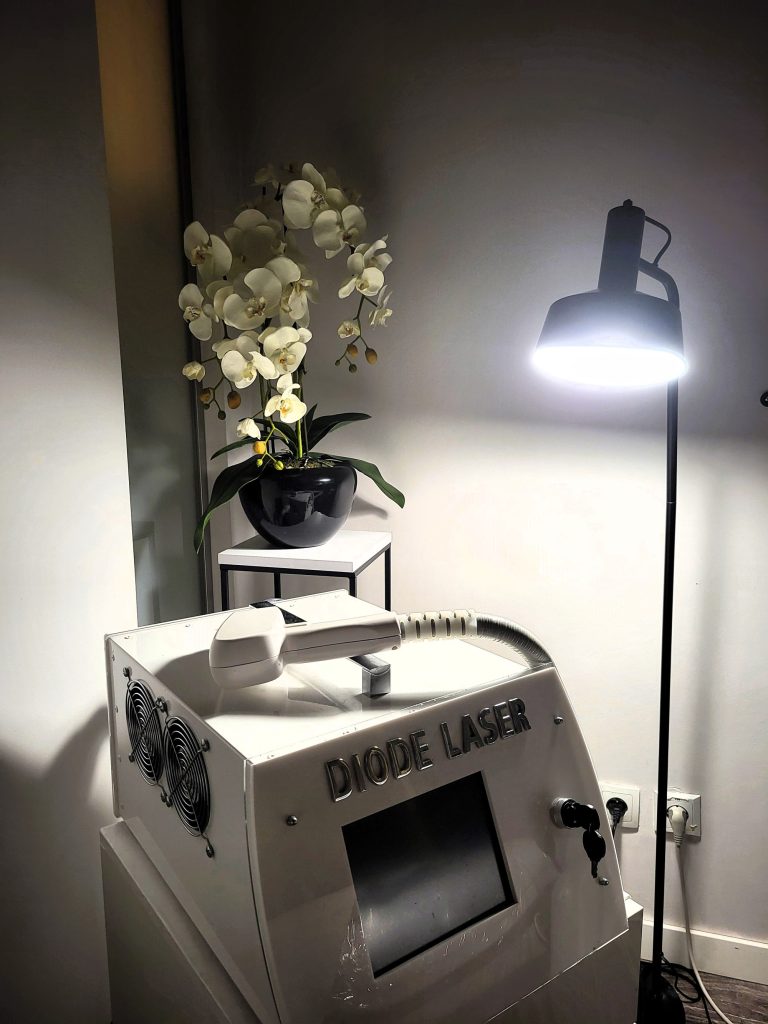SHR Technology in Laser Hair Removal – Everything You Need to Know
Blog BackTable of Contents:
- Introduction to Laser Hair Removal
- How Does Laser Hair Removal Work?
- What is SHR Technology?
- How Does SHR Work in Practice?
- Advantages of the In-Motion Method in SHR
- Why Choose SHR?
- Who is SHR Technology Suitable For?
- What to Expect During an SHR Laser Hair Removal Treatment
- Does SHR Treatment Require Preparation?
- Topic summary

Introduction to Laser Hair Removal
Laser hair removal is one of the most popular and effective methods for removing unwanted hair, offering long-lasting results that are difficult to achieve with traditional methods such as shaving, waxing, or depilatory creams. The key difference lies in how it works: laser hair removal targets the hair follicles, damaging them at the root, which significantly reduces hair regrowth. How exactly does this process work, and what distinguishes SHR (Super Hair Removal) technology in this field? In this article, we’ll cover the details to help you understand the effectiveness and safety of this innovative method.
How Does Laser Hair Removal Work?
Laser hair removal works by emitting a concentrated beam of light at a specific wavelength, targeting melanin—the pigment in hair. The laser’s energy is absorbed by the melanin, converting into heat and damaging the hair follicle without harming the surrounding skin. As a result, hair does not regrow for an extended period, and with regular treatments, it can lead to nearly permanent hair removal.
What is SHR Technology?
SHR, or Super Hair Removal, is a modern technology used in laser hair removal that has a unique approach to energy emission and application, aiming to maximize effectiveness and minimize discomfort for the patient. Unlike traditional lasers, SHR uses not single, high-power pulses but a series of short, low-energy pulses emitted continuously. This allows energy to be distributed more evenly across larger areas of skin, enabling a gentler and more comfortable treatment experience.
How Does SHR Work in Practice?
With SHR technology, energy is gradually delivered to the skin, making the hair removal process more comfortable and safer. Traditional laser hair removal relies on a single, intense energy pulse, which can create a sensation of burning. SHR, on the other hand, uses the In-Motion method, where the laser is moved continuously across the skin's surface. The energy gradually heats hair follicles to the necessary temperature, damaging the hair at its root. This method makes the treatment less painful and more effective on larger areas, such as legs or back.
Advantages of the In-Motion Method in SHR
Greater Comfort: Instead of intense, single-point pulses, In-Motion uses gentler, repeated pulses, which minimize discomfort associated with hair removal.
Even Energy Distribution: The continuous movement technique allows energy to be evenly distributed over the entire treatment area, enhancing the effectiveness of the treatment.
Lower Risk of Irritation: In-Motion reduces the risk of irritation and burns, making SHR safer even for those with more sensitive skin.
Why Choose SHR?
SHR has gained popularity due to its effectiveness and safety. Some of the main benefits of this technology include:
Effectiveness for Different Skin Types: SHR is safe for a wide range of skin types, from light to darker tones. Traditional lasers are often less effective for those with darker skin tones, as melanin is also present in the skin, which can cause irritation. SHR minimizes this risk by gradually heating the skin.
Pain-Free Experience: SHR is one of the least painful laser hair removal methods available. The sensation during the procedure is often compared to mild warming, making SHR suitable even for individuals with a low pain threshold.
Short Treatment Duration: The continuous movement technique allows for faster treatment, which is especially important for larger areas such as legs or back.
Long-Lasting Results: Like other laser hair removal methods, SHR provides long-lasting results that may, over time, lead to near-complete hair removal.
Who is SHR Technology Suitable For?
SHR is suitable for individuals with both light and dark skin tones, as well as for various hair types—from thin, light hair to thicker, darker hair. Because SHR is gentler on the skin, it is often recommended for people with sensitive skin or a low pain threshold. SHR is also ideal for larger areas of the body since the treatment takes less time than traditional laser hair removal.
What to Expect During an SHR Laser Hair Removal Treatment
During the SHR treatment, a cosmetologist applies a special conductive gel to the skin, making it easier to move the laser head while also providing a cooling effect for greater comfort. The specialist then moves the laser head continuously over the chosen area of skin, ensuring even energy delivery to the hair follicles. The entire process is quick and comfortable, with even heating ensuring safety.
Does SHR Treatment Require Preparation?
Yes, as with all laser hair removal treatments, it’s recommended to avoid tanning before the procedure and to apply sunscreen to the treated area. Additionally, the skin should be carefully shaved the day before the treatment to avoid discomfort and enhance the laser’s effectiveness.
Topic summary
SHR technology is a modern solution in laser hair removal that combines effectiveness with patient comfort. By using the In-Motion method and short, gentle pulses, energy is evenly distributed to heat the hair follicles effectively without causing irritation or pain. SHR is an ideal choice for those seeking a safe, painless, and effective hair removal method that works on various skin and hair types.
For beauty salons, investing in SHR technology is also a step toward increasing service quality and client satisfaction. It’s worth investing in advanced devices that provide long-lasting results and comfort during treatments, attracting a wide range of customers.








